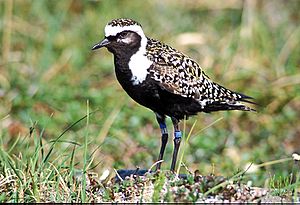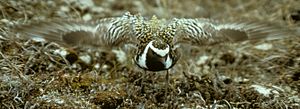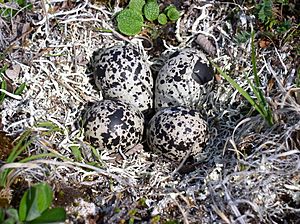American golden plover facts for kids
Quick facts for kids American golden plover |
|
|---|---|
 |
|
| Conservation status | |
| Scientific classification | |
| Genus: |
Pluvialis
|
| Species: |
dominica
|
 |
|
| Synonyms | |
|
Pluvialis dominica dominica |
|
The American golden plover (Pluvialis dominica) is a medium-sized bird. It is a type of plover. The name Pluvialis comes from Latin. It means "relating to rain." People once thought these birds gathered when rain was coming. The name dominica refers to Santo Domingo, which is now Hispaniola in the Caribbean.
Contents
What Does the American Golden Plover Look Like?
This bird is about 9.4 to 11.0 inches (24-28 cm) long. It weighs about 4.3 to 6.8 ounces (122-194 g). Its wingspan is around 25.6 to 26.4 inches (65-67 cm).
When it's breeding season, the adult American golden plover looks very striking. Its face, neck, chest, and belly are black. It has a white stripe over its head and neck. This stripe goes down to the sides of its chest. Its back is a mix of black and white. It also has pale, gold spots. Female birds look similar but have less black color.
In winter, both male and female birds change their look. Their upper parts become grey-brown. Their undersides are a lighter grey-brown. They also have a whitish stripe above their eyes. This bird has a small head and a small beak.
This plover looks a lot like two other golden plovers. These are the European and Pacific golden plovers. The American golden plover is smaller and thinner. It also has longer legs than the European golden plover. The European one has white feathers under its wings. The American plover is more like the Pacific golden plover. They were once thought to be the same species. The Pacific golden plover is thinner. It has shorter wing feathers and longer legs. Its back is usually more yellow.
Where Do American Golden Plovers Live?
American golden plovers breed in the Arctic tundra. This area is in northern Canada and Alaska. They build their nests on the ground. They choose dry, open spots for their nests.
These birds are migratory. This means they travel long distances. They spend their winters in southern South America. They follow a special oval-shaped migration path. When they fly north, they go through Central America. This happens from January to April. Many birds gather in places like Illinois before flying further north. In the fall, they take a different route. They fly mostly over the western Atlantic Ocean and Caribbean Sea. They head to their winter homes in Patagonia.
This bird has one of the longest known migration routes. It flies over 25,000 miles (40,000 km)! About 2,400 miles (3,900 km) of this journey is over open ocean. They cannot stop to eat or drink during this part. They use fat stored in their bodies to fuel this long flight. Sometimes, these birds are seen in western Europe. This is unusual for them.
Some historians believe these plovers helped Christopher Columbus. In October 1492, after 65 days at sea, he saw many shore birds. These birds likely helped him realize land was near.
How Do American Golden Plovers Behave?
Breeding and Nests
These birds make simple nests called scrape nests. They line their nests with things like lichens, grass, and leaves. When they are breeding, they are very protective of their territory. They will act aggressively towards other birds nearby. Some American plovers also protect their territory in their winter homes.
The female American golden plover lays four eggs. The eggs are white to light brown. They have many black and brown spots. Each egg is about 1.9 by 1.3 inches (48 by 33 mm). The eggs are incubated for 26 to 27 days. The male bird sits on the eggs during the day. The female bird sits on them at night. The chicks hatch ready to move. They leave the nest within hours. They can find their own food within a day.
What Do They Eat?
These birds look for food in different places. They search in tundras, fields, beaches, and tidal flats. They usually find their food by looking for it. Their diet includes insects and crustaceans.
Status of the American Golden Plover
Many American golden plovers were hunted in the late 1800s. Their population has not fully recovered since then.
See also
 In Spanish: Chorlito dorado chico para niños
In Spanish: Chorlito dorado chico para niños




